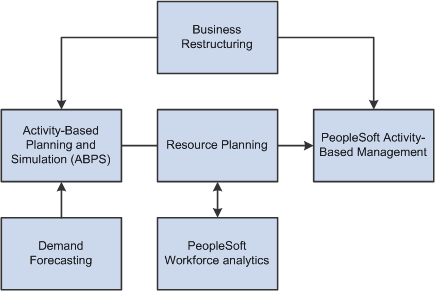Understanding ABPS
This section provides an overview of ABPS and discusses:
Planning activity types and ABPS models.
Spending patterns.
Planning techniques.
Activity-Based Management features Activity-Based Planning and Simulation (ABPS), a planning and simulation feature that forecasts values for your models. You can use an ABPS model that is based on existing Activity-Based Management values to calculate activity and resource demands, new rates, and cost and activity volumes based on demand forecasts. ABPS converts the new resource demands into new cost requirements at the general ledger item level and uses that for budgeting input.
PeopleSoft ABPS uses spending patterns and data from PeopleSoft Workforce Analytics to calculate the new resource cost for the estimated resource requirement based on the volume forecast. You can use planning techniques with ABPS that enable you to assign the resource costs to activities, cost objects, and calculate the new driver rates and object rates.
Planning Activity Types and ABPS Models
With ABPS you can perform the following three types of planning activities:
Business restructuring.
Demand planning.
Resource planning.
Forecasting using any of these planning activity types is an iterative process. You enter forecast values, run the forecasts, review the results, modify values if necessary, and repeat the process until the results seem reasonable.
Forecasting with ABPS is possible through the use of object-based modeling. The ABPS model must always be the child of an Activity-Based Management parent model with changes made for business planning and forecasting volumes. The original model from which the ABPS model is derived is called the base model.
The ABPS model can have the following changes from the base model:
Driver changes to represent business planning.
Volume changes to represent demand planning.
Budget constraints to represent resource planning.
Business Restructuring
Business restructuring focuses on eliminating unneeded activities by changing the drivers. You create an ABPS model that uses new or changed objects (resources, activities, or cost objects) and drivers. Then you run the Activity-Based Management engine to calculate the new driver and object rates.
Demand Planning
Demand planning focuses on studying the impact of cost object and activity volumes. You can change the cost object or activity volumes in the ABPS model. The ABPS engine then compares these forecasted volumes with actual volumes in the master model to obtain the percentage change. ABPS uses the change in volume to calculate the resource demand and its cost. ABPS directs the resource cost to the general ledger line item to calculate the budget data. The Activity-Based Management engine subsequently directs the new resource cost to the activities and cost objects to calculate the new driver and object rates, and cost object costs.
Resource Planning
Resource planning focuses on resource allocations that create expected results such as driver rates and cost object costs. Resource allocation can be changed either manually or can be the result of an interface with other applications such as PeopleSoft Workforce Analytics. The ABPS model used for resource planning may include costs mapped from general ledger line items and is created according to business unit, model, fiscal year, and accounting period. The Activity-Based Management engine runs this model to calculate new drivers, object rates, and cost object costs.
You set up resource planning on the Resources Definition page. After completing your setup, you can save your work to the Ledger Mapping table (PF_LEDMAP_F00) and use it to assign the costs activities and cost objects.
Resource planning can be done using budget constraints, in which case it will not have manual interaction.
You can perform all three planning types at the same time.
Image: ABPS flow for different forecasting types
The following diagram illustrates the flow for the different PeopleSoft ABPS forecasting types.

Spending Patterns
Your resources exhibit some sort of spending pattern. It's important that you identify that pattern and associate the resource with that spending pattern within the system.
Use the following criteria as guidelines:
You can choose from the following patterns: flexible, fixed, and practical capacity.
If the resource is flexible, then use 100 percent flexible (line method).
If the resource is committed, but is assigned mostly to unit or batch activities, then use 100 percent practical capacity. This enables an increase in resources if demand increases. There is no need to change resources if demand decreases (unless demand falls to zero percent).
If the resource is committed, but is not assigned to unit or batch activities, then use zero percent practical capacity. This indicates that there will be no changes in resources unless demand falls to zero.
Image: Example of resource flow through a model
The following diagram illustrates how the ABPS engine calculates resources.

The following table lists the calculations the system uses to move demand forecast costs through the model.
|
Calculation |
Formula |
|---|---|
|
New Resource Cost |
Step (new driver quantity * driver rate) |
|
Percent Change in Resource Cost |
((New resource cost * old resource cost) / old resource cost)) � 100 |
|
New Unit Volume |
Old volume + (old volume * percentage of change) |
|
Percent Change |
((New volume * old volume) / old volume) � 100 |
|
New Driver Quantity |
Old quantity + (old quantity * percentage of change) |
Planning Techniques
ABPS uses planning techniques for assigning resource costs to activities and cost objects. These planning techniques also calculate the new driver rates and object rates:
There are two available planning techniques:
| Fully Loaded |
Uses calculated rates from the base model to calculate resource cost. |
| Capacity Adjusted |
Uses capacity rates to calculate resource cost. |
Although planning techniques are used to calculate the resource cost, the final resource budget cost is calculated based on the spending pattern data. If you have not defined a spending pattern, then the cost (as calculated with the planning technique) is used for budgeting. For either technique, set up the model as an actuals model.